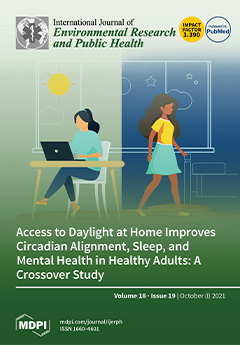Open AccessArticle
Psychosocial Impact of the COVID-19 Pandemic on Healthcare Workers and Initial Areas of Action for Intervention and Prevention—The egePan/VOICE Study
by
Lucia Jerg-Bretzke, Maximilian Kempf, Marc Nicolas Jarczok, Katja Weimer, Christian Hirning, Harald Gündel, Yesim Erim, Eva Morawa, Franziska Geiser, Nina Hiebel, Kerstin Weidner, Christian Albus and Petra Beschoner
Cited by 28 | Viewed by 5055
Abstract
Introduction: Epidemics lead to an increase in occupational stress and psychological strain among healthcare workers. However, the impact of a pandemic outbreak on healthcare systems is yet to be clearly defined. Therefore, this work aims to describe and analyze specific areas of workload
[...] Read more.
Introduction: Epidemics lead to an increase in occupational stress and psychological strain among healthcare workers. However, the impact of a pandemic outbreak on healthcare systems is yet to be clearly defined. Therefore, this work aims to describe and analyze specific areas of workload among different groups of healthcare workers during the first wave of the COVID-19 pandemic. Methods: A sample of N = 8088 persons working in the German-speaking healthcare sector participated in the VOICE/egePan online survey, which addressed the impact of the COVID-19 pandemic during the second quarter of 2020. We used 15 self-constructed items, based on the work of Matsuishi et al. (2012), to identify potential COVID-19-specific topics. Results: N = 7542 records of healthcare workers were analyzed. Of these, 60.80% reported, retrospectively, an increase in stress since the outbreak of the pandemic. Problem areas tended to be indicated more frequently by the women surveyed than by the men. Nurses, paramedics and medical technicians reported the highest fear of infecting others while physicians reported the highest fear of physical or mental exhaustion. With respect to age, older respondents indicated less fear and felt more protected. Men and people living alone were more likely to use dysfunctional coping strategies. Migrants reported a higher fear of becoming infected or infecting others as well as they reported about increased levels of smoking. Discussion: Retrospectively, the COVID-19 pandemic led to an increase in stress among healthcare workers. Problem areas have different focuses with regard to different living situations, environmental conditions and professions. In order to lay the best basis for healthy and efficient work, it seems necessary to take measures especially tailored to the needs of different groups of healthcare workers.
Full article
►▼
Show Figures





